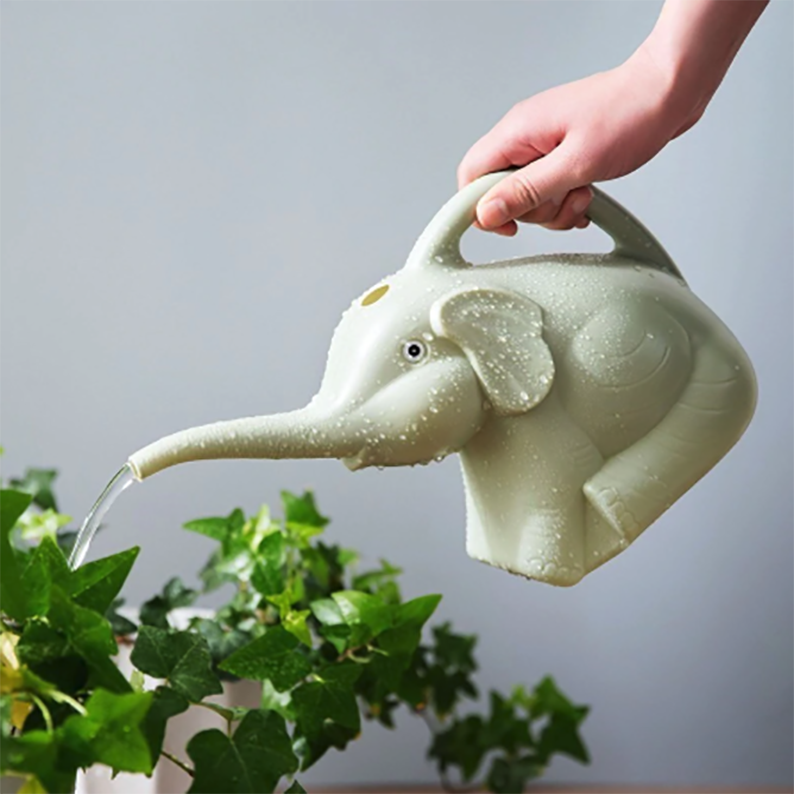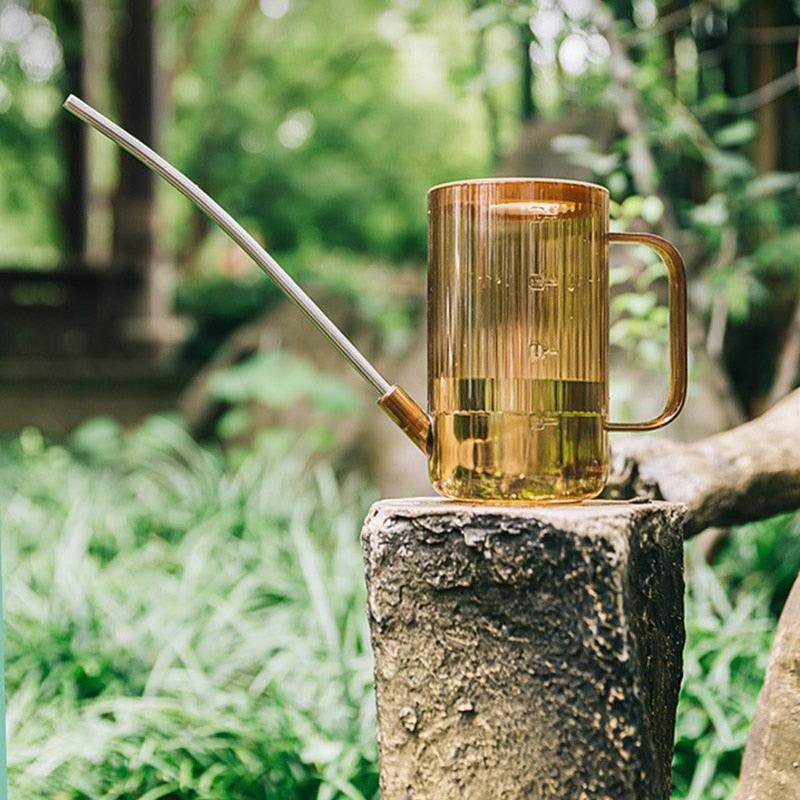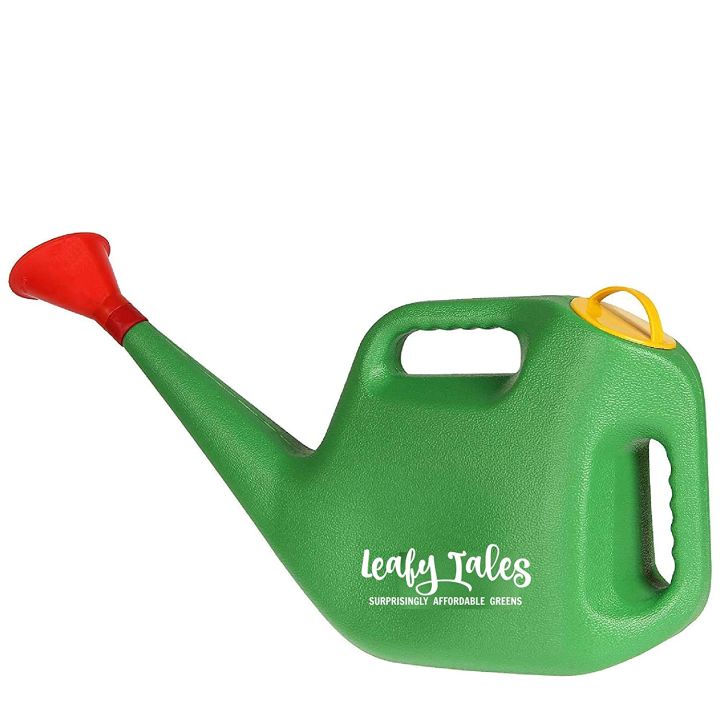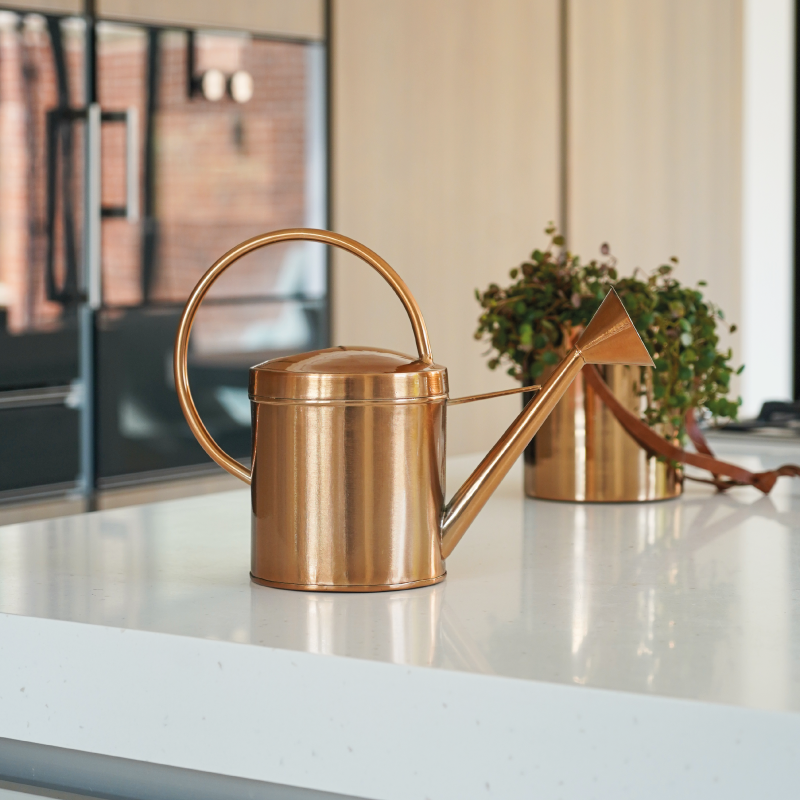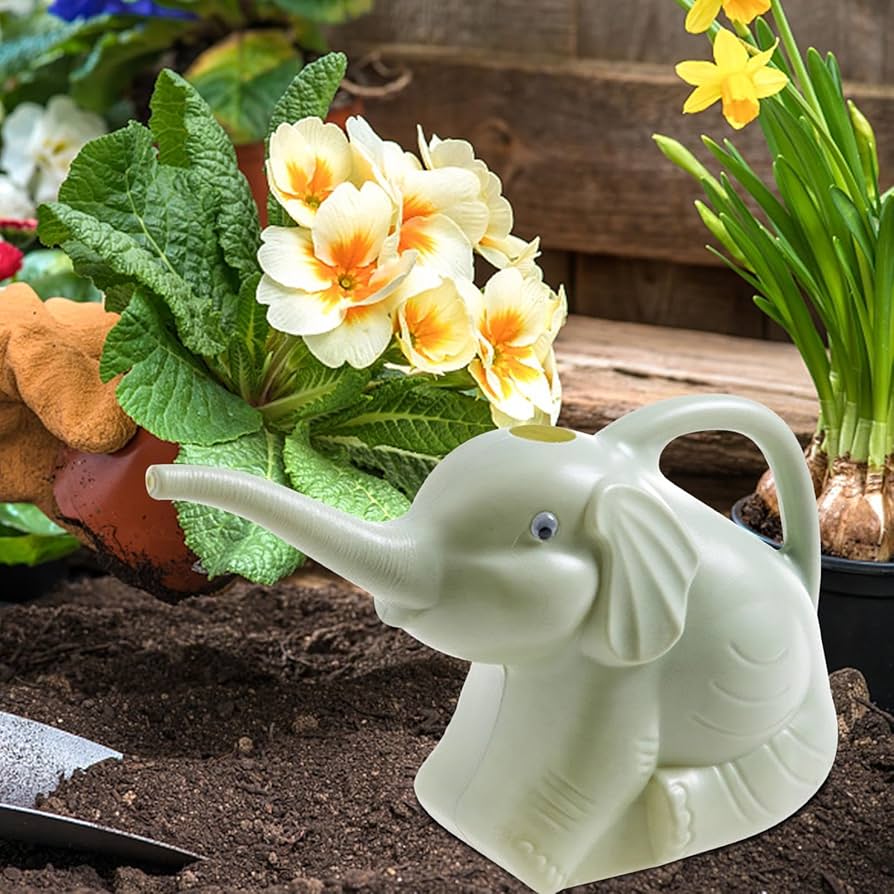
Creative Gardening : An Elephant Watering Can with Playfulness
Unveiling the Charm of Elephant Watering Cans
Elephant watering cans aren’t just tools; they’re a unique touch to any garden. Their design captures the essence of playfulness and creativity. With their trunks raised high, these cans delight gardeners and nature lovers alike. Let’s delve into what makes elephant watering cans so special.
First off, their eye-catching design stands out. Unlike standard cans, these feature the adorable shape of an elephant. They turn a mundane task into something fun. Both kids and adults enjoy using them, making garden work a family affair.
Next, we notice the craftsmanship. Many elephant watering cans show fine details and colors. This adds whimsy to the daily watering routine. More than that, these cans can serve as decorative pieces. When not in use, they sit as cute ornaments among your plants.
Also, functionality pairs with the charm. A well-designed elephant watering can isn’t just for show. It should pour water smoothly from the trunk, giving you control over watering. This way, caring for your plants becomes simple and enjoyable.
Lastly, using an elephant watering can can inspire others. Seeing one in action might motivate friends and neighbors to embrace gardening. It shows how a little creativity can brighten everyday tasks.
In short, elephant watering cans bring joy and charm to the gardening experience. They blend fun design with practical use. As we explore further, we’ll find out what history they carry and how to pick the perfect one for your garden.
A Brief History of Novelty Watering Cans
The history of novelty watering cans is as rich as it is fascinating. Long before the elephant watering can made its playful entry into gardens, novelty watering cans were adding splashes of creativity to gardening. The concept began as a way to blend practicality with amusement.
In the 19th century, novelty cans appeared with the rise of the middle class. Gardeners wished to express individuality in their gardening tools. The cans often came in shapes like swans, ducks, and even mythical creatures. Their popularity grew as a statement of personal style.
The elephant watering can is a more recent addition. It joins the family of novelty cans as a beloved figure. Its unique shape draws inspiration from the natural world and exotic locales. It’s more than a garden tool; it’s a nod to wildlife and the joy they bring into our lives.
Figures from pop culture also found their way into watering can designs. These cater to fans and collectors. Over time, novelty watering cans became collectible items. Today, they spark joy and nostalgia, reminding us of the playfulness inherent in gardening.
Elephant watering cans, with their charming appearance, continue this tradition. They represent a blend of history, art, and functionality. They are a modern touch in the evolving story of novelty watering cans. Their presence in gardens keeps the whimsical spirit alive, connecting gardeners to a history of delight in everyday chores.
Essential Features to Consider When Choosing an Elephant Watering Can
When shopping for an elephant watering can, it’s important to think about several key features. These features will ensure that your can is not only cute but also functional and durable. Here are the essential features to consider:
- Design and Size: The design should reflect your style while being easy to handle. Pick a size that suits the scope of your gardening activities.
- Material: Plastic and metal are common. Metal lasts longer, but plastic is lighter. Think about which material fits your gardening needs best.
- Spout Length and Shape: The trunk, acting as the spout, should allow a precise stream of water. It will help you reach plants more easily.
- Capacity: Choose a watering can that has a capacity suitable for your garden. You want to avoid frequent refills.
- Ergonomics: The handle should be comfortable to hold, even when the can is full. This makes watering less tiring.
- Color and Finish: Colors can fade in the sun. Consider a can with UV-resistant colors or paint if it will be outdoors a lot.
- Durability: Good quality materials and construction mean your watering can will last many seasons.
- Price: Balance quality with how much you’re willing to spend. A good watering can is an investment in your gardening comfort.
By considering these features, you’ll find an elephant watering can that is a perfect balance of form and function, enhancing your gardening experience.
Integrating Elephant Watering Cans into Your Garden Decor
Elephant watering cans do more than water plants. They add character to your garden space. When picking one, imagine how it fits with your garden’s theme. A playful elephant can become a focal point in a whimsical setting.
Here are some tips to blend these cans into your garden decor:
- Use as a Centerpiece: Place your elephant watering can at the heart of your garden. Set it among flowers or on a decorative table.
- Pair with Plant Colors: Match the can’s color with nearby blooms. This creates harmony in your garden’s color palette.
- Create a Theme: Let the elephant can inspire a wildlife or safari theme. Add similar decorations to complete the look.
- Functional Art: Display your can where it’s easy to grab. Make it part of your routine, not just decor.
- Seasonal Switch: Change the can’s location with the seasons. This keeps your garden looking fresh.
Choosing an elephant watering can brings two benefits. It aids in plant care and lifts the garden’s aesthetic. Remember these tips and your garden will shine with personality.
DIY Guide: Crafting Your Own Elephant Watering Can
Crafting your own elephant watering can adds personal flair to your garden tools. If you’re feeling crafty, follow these simple steps to create a unique and functional piece for your gardening routine. Here’s how to get started:
- Gather Materials: You’ll need a sturdy plastic jug, permanent markers, paint, brushes, and a cutting tool.
- Design Outline: Sketch the elephant’s body shape on your jug. Include the trunk where the water will pour from.
- Cut and Shape: Carefully cut out the elephant’s silhouette from the jug. Smooth any rough edges.
- Paint Details: Use the markers and paint to add eyes, ears, and any other details to your elephant. Let the paint dry completely.
- Test Water Flow: Fill the can and test the water flow from the trunk. Make adjustments if necessary.
- Seal and Protect: Apply a clear sealant over the paint to protect it from water and sun damage.
- Personal Touch: Add your personal touch with additional decorations or accessories.
By following these steps, you’ll craft a watering can that’s not only practical but also a reflection of your creativity. It makes watering plants a delight and serves as a quirky addition to your garden decor. Plus, crafting your own elephant watering can will surely inspire conversation and a smile whenever you use it or show it off to friends and neighbors.
The Best Elephant Watering Cans on the Market
When searching for the ideal elephant watering can, there’s a range to choose from. Here’s a highlight of some of the best available on the market, offering balance in design, functionality, and price:
- The Classic Plastic: These cans are affordable and lightweight, perfect for daily use. They often come in vibrant colors, appealing to children’s love for bright objects.
- The Durable Metal: Metal elephant watering cans are sturdy and can withstand the elements. They usually have a vintage charm that appeals to collectors and traditionalists.
- Designer Touch: Some cans boast unique features by designers. They blend artistic vision with utility. Although higher in price, they make for a stunning piece in any garden.
- Eco-Friendly Options: Look for cans made from recycled materials. They’re good for the planet and add a sustainable touch to your garden tools.
- Multipurpose Cans: These watering cans don’t just water plants. They come with additional features like sprinkler heads for various gardening tasks.
When choosing an elephant watering can, consider how it will fit into your life. Whether it’s for everyday garden care, a gift for a nature-loving friend, or as part of your decor, the best choice combines your needs with whimsy and utility.
Caring for Your Elephant Watering Can: Maintenance Tips
Looking after your elephant watering can is key to its longevity. Here are practical tips to maintain it:
- Regular Cleaning: Empty and rinse your can after each use to prevent mold.
- Avoid Sun Damage: Store it away from direct sunlight to keep colors bright.
- Check for Leaks: Inspect the bottom and the trunk regularly for any holes or cracks.
- Gentle Use: Handle with care to avoid dents and damage, especially if it’s metal.
- Winter Storage: Drain and keep indoors during cold months to prevent freezing and cracking.
- Touch-Up Paint: Apply touch-up paint as needed to cover any scratches or chips.
- Handle with Care: Ensure to grip the handle firmly to prevent drops and slips.
- Proper Refilling: Use a hose or faucet gently to avoid denting when refilling.
By following these tips, your elephant watering can will keep its functionality and charm. Treat it well, and it will delight your garden for seasons to come.
Inspiring Ideas for Using Your Elephant Watering Can Beyond Gardening
Elephant watering cans aren’t just for gardens. Their unique design can serve many creative uses. Here’s how to use your elephant watering can for different purposes:
- Indoor Plant Care: It’s perfect for watering indoor plants. Its design adds charm to your interior decor.
- Children’s Water Games: Kids can use it to play water games during summer. It’s fun and safe for them.
- Home Decor: When not in use, it makes a cute decor piece. Place it on a shelf or table.
- Crafting Projects: Use it in crafting. It could be a part of an art project or a painting activity.
- Outdoor Fun: Fill it with bubble solution for kids to blow bubbles in the yard.
- Educational Tool: Teach children about watering plants or wildlife through play.
- Unique Vase: Use it as a quirky vase for fresh or dried flowers.
- Party Accessory: At garden parties, use it to hold utensils or as a centerpiece.
With these ideas, your elephant watering can brings value beyond gardening. Use it wisely, and it becomes a multipurpose tool. Whether for care, play, or decor, it proves to be a versatile item in any home.
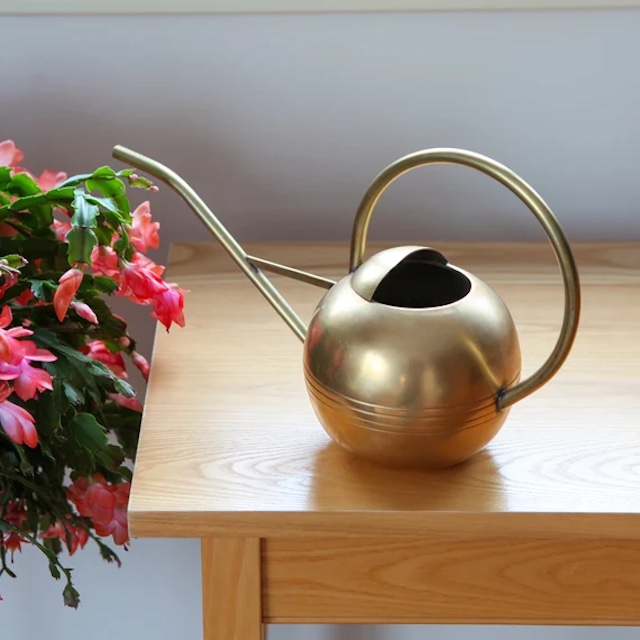
Outdoor Gardening: Essentials of Brass Watering Can Care
The Benefits of Using a Brass Watering Can
Choosing a brass watering can for your gardening tasks comes with a variety of benefits. Not only does its charming aesthetic appeal add a touch of elegance to your gardening toolkit, but brass watering cans also offer practical advantages.
Firstly, brass is a robust material known for its durability. This means that a brass watering can is likely to last longer than cans made from other materials, ensuring value for money in the long run.
Another benefit is the natural resistance of brass to rust. Watering cans are regularly exposed to moisture, so having one that won’t rust easily is a significant plus. This feature reduces maintenance hassles and also keeps the water cleaner.
Brass watering cans also tend to have superior balance and control, which stems from their quality construction. This makes watering plants more precise, avoiding water waste and ensuring that water goes exactly where it’s needed – to the roots of your plants.
The heft of a brass watering can provides another hidden advantage. It offers a stable heft that resists tipping over in windy conditions, which can be particularly useful for outdoor gardening.
Finally, brass watering cans are often considered works of art in themselves. Their classic design makes them a stylish accessory that can enhance the overall aesthetic of your garden or home.
In summary, opting for a brass watering can can offer longevity, rust resistance, precision in watering, stability, and a touch of style to your gardening practice. These benefits combine to not only make your gardening more effective but also more enjoyable.
Key Features to Look for in a Quality Brass Watering Can
When choosing a brass watering can, several key features ensure its quality and functionality. Look for these essentials to make sure you get the most out of your investment:
- Durability: The brass should be thick and solid to withstand frequent use and potential impacts. A sturdy construction means your can will last many seasons.
- Ergonomic Design: A well-designed handle and spout provide comfort and ease during use. It should feel balanced in your hand and pour water smoothly.
- Corrosion Resistance: High-quality brass should resist corrosion. Check for a clear protective coating that will keep the can looking new for longer.
- Capacity: Consider how much water you need. A larger capacity means fewer trips to refill, but it should not be so heavy that it’s hard to carry.
- Aesthetics: Choose a design that complements your garden. A polished finish or decorative details can add beauty to the utilitarian object.
- Balance: The can should not tip over when set down. A stable base and the right weight distribution are important for ease of use.
- Spout Length: Look for a spout that is long enough to reach your plants without straining. A detachable or adjustable spout can be a bonus.
Selecting a brass watering can with these features will ensure it is not only a practical tool for your gardening but also a lasting part of your gardening ensemble.
Step-by-Step Guide to Cleaning Your Brass Watering Can
To keep your brass watering can in top condition, regular cleaning is essential. Here’s a simple, step-by-step guide to help you maintain the luster and functionality of your brass watering can:
- Empty the Can: Ensure it is completely empty of water to prevent diluting the cleaning solution.
- Prepare a Cleaning Solution: Mix warm water with a gentle dish soap. Avoid harsh chemicals that can damage brass.
- Scrub Gently: Use a soft cloth or sponge to wipe the surface. Scrub inside and out to remove dirt and grime.
- Rinse Thoroughly: After scrubbing, rinse the can with clean water. Make sure no soap residue remains.
- Dry Completely: Use a soft towel to dry the watering can. Ensure it’s completely dry to prevent water spots.
- Polish if Needed: If your can has lost its shine, use a brass polisher. Apply a small amount and rub it in with a soft cloth.
- Wipe with a Dry Cloth: Finish by buffing with a clean, dry cloth for a gleaming surface.
- Reassemble the Can: If your can has a detachable spout, put it back together carefully.
By following these simple steps, you’ll help your brass watering can resist tarnish and maintain its beauty. Regular cleaning not only maintains appearances but also ensures that your gardening tool performs well for years to come. Use the brass watering can with care, and it will remain a functional and stylish part of your gardening routine.
Preventing Tarnish and Corrosion on Brass Watering Cans
Keeping your brass watering can tarnish and corrosion-free is important. Simple steps can ensure its longevity. Here’s how to prevent these issues:
- Keep It Dry: Always empty your brass watering can after use. Water residue can lead to tarnish and corrosion. Wipe it down with a soft cloth to remove any remaining moisture.
- Store Correctly: Do not leave your brass watering can outside. Exposure to the elements can cause tarnishing. Store it in a dry, sheltered place when not in use.
- Use Natural Cleaners: For regular cleaning, avoid harsh chemicals. They can strip away protective layers. Use lemon juice and baking soda for a gentle, natural clean. Apply with a soft cloth, then rinse and dry.
- Regular Polishing: Lightly polish your brass watering can with a suitable brass polish. This adds a protective layer to prevent tarnish. Do this every few months, or as needed.
- Avoid Dents and Scratches: Treat your brass watering can with care. Dents and scratches can damage the surface. This damage makes it easier for tarnish and corrosion to take hold.
- Monitor for Signs of Wear: Inspect your can regularly. Look for any changes in color or small spots. These can signal the start of tarnish and corrosion. Take action early to clean and protect the area.
By following these tips, your brass watering can will remain a beautiful and functional tool in your garden.
Storing Your Brass Watering Can to Prolong Its Life
Proper storage is key to extending the life of your brass watering can. Here are some tips to ensure it remains in the best condition:
- Pick a Dry Location: Store your can in a dry place. Moisture can cause tarnish and corrosion.
- Avoid Direct Sunlight: Keep your can away from direct sunlight. Sun can heat the brass and cause discoloration.
- Use a Protective Cover: Consider a cloth cover to keep dust and dirt away.
- Keep It Elevated: Place your can on a shelf or in a cabinet. This avoids direct contact with damp floors.
- Use Pads or Liners: If you must store it on the ground, use rubber pads or liners for protection.
- Avoid Stacking: Do not pile items on or around the can. This can cause scratches and dents.
- Store Empty: Make sure your watering can is empty before storing. This prevents water from stale.
Storing your brass watering can with care will make it last longer and stay bright and functional.
Common Issues and Troubleshooting for Brass Watering Cans
Even with meticulous care, your brass watering can may face some common issues. Understanding these can help you troubleshoot effectively.
- Leaks: If you notice water leaking, check the seams and joints. Apply a sealant or solder to repair minor leaks.
- Clogged Spout: A blocked spout can hinder watering. Clear any debris with a thin wire or by running water through it.
- Discoloration: Brass can discolor over time. Clean it with a mix of lemon juice and baking soda to restore its color.
- Dents: Small dents can often be smoothed out. Gently tap the dented area with a soft mallet from the inside.
- Loose Handle: Tighten any screws on the handle. If it’s soldered, a professional may need to reattach it.
- Corrosion: Corrosion spots may appear. Clean them with a brass polish and protect the area from moisture.
- Calcium Build-Up: Hard water can leave calcium deposits. Use vinegar to dissolve the build-up, then rinse well.
By addressing these issues promptly, you can keep your brass watering can in working order. Regular checks and maintenance will help you avoid many of these problems.
Enhancing Your Gardening Experience with a Well-Maintained Brass Watering Can
Caring for your brass watering can not only prolongs its life but also enhances your gardening experience. Here are some ways to keep your can in great shape for an enjoyable gardening routine:
- Inspect Regularly: Check your brass watering can often for any signs of damage or wear. Catching issues early on can prevent bigger problems later.
- Gentle Use: When watering, handle your can with care. Avoid dragging it across hard surfaces or knocking it against objects.
- Balance Watering Loads: Don’t overfill to prevent heavy lifting. This keeps you comfortable and the can in good condition.
- Proper Post-Use: After watering, empty the can entirely. Then wipe it down to eliminate any moisture that can cause issues.
- Mindful Placement: Place your can gently on surfaces. Dropping or tossing it might dent or damage the brass.
- Efficient Watering: Ensure you water plants at their base. This saves water and targets the roots. Your brass watering can’s design aids in this precise watering.
Following these tips ensures a positive gardening experience. A well-maintained brass watering can is reliable, easy to use, and a delight to own. It makes gardening tasks less of a chore and more of a peaceful hobby.
Creative Ways to Display Your Brass Watering Can When Not in Use
When not in use, your brass watering can is more than just a tool. It’s a piece of decor that can add charm to any room or garden space. Here are some creative ideas to display your can elegantly:
- In the Garden: Use it as a centerpiece. Place your brass watering can amid your flowers. It will shine in the natural light and show off its design.
- On Shelves: Display it on a shelf. Surround it with potted plants or gardening books. This elevates the can to an art piece.
- Near the Entrance: Make it a welcome sight. Set it by your front door. It can hold fresh flowers and greet guests.
- With Garden Tools: Create a tool arrangement. Group your brass watering can with other gardening tools. This can turn a utilitarian space into a charming nook.
- As Kitchen Decor: Include it in the kitchen. A brass watering can can hold cooking utensils or just sit prettily on a counter.
- In the Living Area: Position it in a living space. Place it on a mantelpiece or coffee table. It brings a touch of the outdoors inside.
- Hanging Up: Use hooks to hang your can. This keeps it off the ground and can fill empty wall space beautifully.
Remember, when displaying your brass watering can, keep it away from moisture and direct sunlight to prevent tarnish. A well-placed can is not only a practical watering tool but also a statement piece that reflects your style and love for gardening.
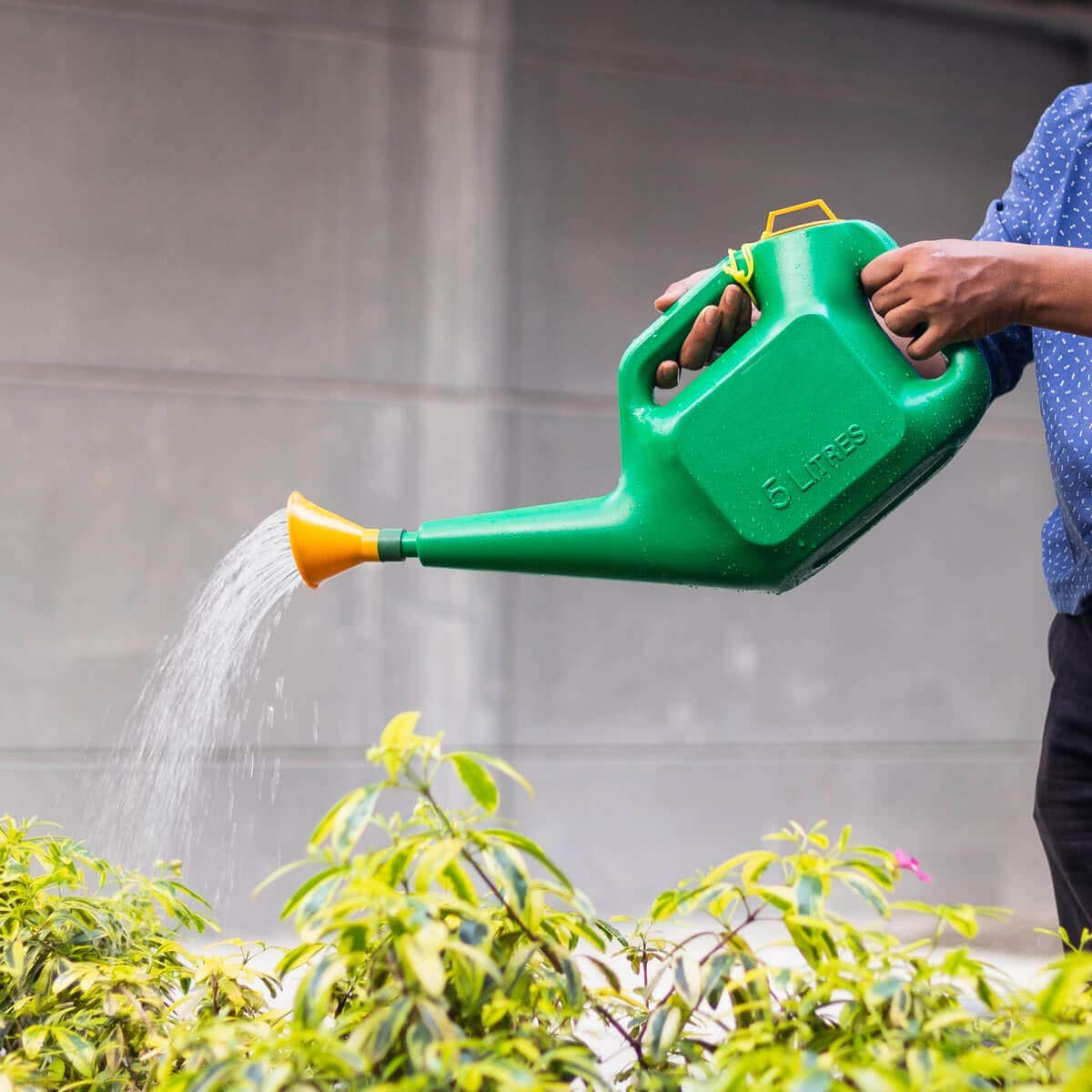
Efficient Designs for Healthy Plants: Watering Can for Plants
The Importance of Proper Watering for Plant Health
Water matters much for plant health. Water carries nutrients from soil to plant cells, aiding growth. Over-watering and under-watering can harm plants. The right watering can for plants helps avoid these issues. It lets you control water flow and volume. This ensures plants get enough water without waste. Good watering prevents root rot and soil erosion. It also stops salt buildup in the soil. Proper watering supports photosynthesis and plant respiration too. For healthy plants, choose the right watering can and use it well.
Different Types of Watering Cans
When choosing a watering can for plants, gardeners have several options. Each type has unique features suitable for specific gardening tasks. Here are the main types to consider:
Plastic Watering Cans
Plastic cans are lightweight and affordable. They come in various shapes and sizes. These cans resist rust and are easy to clean. They work well for indoor plants and small gardens.
Metal Watering Cans
Metal cans are sturdy and last long. They usually have a traditional look, appealing for some gardeners. These are ideal for outdoor gardens but can be heavier.
Galvanized Watering Cans
Galvanized cans have a metal body with a protective zinc coating. This prevents rust, making them a durable option for many climates.
Decorative Watering Cans
These are designed to look good while being functional. They are perfect for those who want style along with performance for their gardening chores.
Collapsible Watering Cans
For easy storage, collapsible cans are great. They are perfect for gardeners with limited space. These cans expand for use and collapse after.
Self-Watering Cans
These have built-in systems that release water slowly. They are an excellent choice for consistent watering without daily attention.
Each type of watering can serves a distinct purpose. When selecting one, consider the size of your garden and your specific watering requirements. The right watering can make all the difference in keeping your plants healthy and thriving.
Key Features to Look for in a Watering Can Design
When shopping for a watering can for plants, thoughtful features can make garden work easier. Consider these key aspects to find the best can for your garden:
- Spout Length and Design: A long spout reaches plants easily, reducing strain. A removable rose attachment helps control water flow, allowing for a gentle shower that won’t disrupt the soil or harm delicate plants.
- Handle Comfort: Look for cans with an ergonomic handle. A comfortable grip reduces hand fatigue during extended use. This is especially important for gardeners who tend to large areas or water frequently.
- Balance and Control: A good design offers balance when full or empty. Cans should be easy to tilt, ensuring precise watering without unnecessary spillage.
- Volume Markings: Some watering cans have visible volume markings. These help you measure how much water you’re giving your plants, promoting consistency in watering routines.
- Material Quality: Check for high-quality materials that withstand the elements. Durability is key, whether it’s a rust-resistant metal or a UV-protected plastic.
- Lid Closure: A secure lid prevents spills and keeps water clean. Some designs come with a lid to avoid contamination from leaves and insects.
When these features are present, a watering can becomes more than just a container—it’s a tool that enhances gardening efficiency and plant health. Keep these points in mind to select a can that meets your needs, and ensures your plants flourish. Remember, a well-designed watering can is an investment in your garden’s future.
Ergonomic Watering Can Designs for Comfortable Use
When it comes to extended gardening sessions, comfort is key. A watering can with an ergonomic design can drastically reduce the strain on your hands and back. The factors listed below contribute to an ergonomic watering can design that ensures comfortable and efficient use:
- Handle Position and Shape: Seek watering cans with handles that are positioned for natural arm alignment. Handles with curves fit better in the hand and make pouring more comfortable.
- Weight Distribution: An optimally designed watering can distributes weight evenly. This feature minimizes wrist strain as you tilt the can to water plants.
- Adjustable Straps: Some modern watering cans come with adjustable straps. They allow you to support the weight with your shoulder, easing hand stress.
- Hand Clearance: Look for a can with ample space between the handle and the body. Adequate clearance avoids knocking your knuckles against the can, which can be painful.
Ergonomic watering cans combine functionality with comfort. They cater to gardeners who spend long hours caring for their plants. In selecting an ergonomic watering can for plants, ease of use becomes as important as the can’s watering capabilities. By choosing a can with these design considerations, gardeners can enjoy a more pleasant and less physically demanding gardening experience.
Innovative Watering Can Features for Enhanced Efficiency
Innovation in watering cans brings efficiency to gardening. Here are cutting-edge features that boost performance:
- Built-In Measuring Scales: Some cans have scales to measure water precisely. This helps give each plant the right amount.
- Dual Handles: Offers better control during pouring. One handle is for carrying, the other for tilting.
- Detachable Spouts: Allow for easy cleaning and the choice of different pouring speeds.
- Push-Button Flow Control: This modern feature lets you start and stop water with a button press.
- Water Level Indicator: Some cans show water levels without opening the lid. This is handy for quick checks.
- Integrated Fertilizer Mixers: Some designs allow you to mix fertilizer with water. This ensures nutrients spread evenly.
- Lockable Trigger Mechanism: A lock feature is good for longer watering tasks. It prevents hand fatigue from constant squeezing.
- Space-Saving Design: Innovative cans can be stacked or nested. This saves space in storage areas.
These features make watering cans more than a tool. They turn watering into a precise and enjoyable gardening activity. Choose a can with these innovative functions to save time and effort.
Watering Can Materials: Durability and Sustainability
Choosing the right material for your watering can is crucial. It affects both durability and sustainability. Let’s dive into the types of materials you can find in watering cans.
- Plastic: This is common for watering cans. High-quality plastic resists UV damage and cracking. Opt for ones made from recycled plastic to aid sustainability.
- Metal: Metal options are often more durable. They can take a beating and last for years. If you want a sustainable pick, go for a can that’s recyclable at the end of its life.
- Galvanized Steel: This material has a zinc coating to fight rust. It offers a long lifespan and tough performance. Choose galvanized steel for resistance against harsh elements.
- Stainless Steel: A high-end material that won’t rust or corrode. Stainless steel is ideal for lasting quality. It’s a heavier option but worth the investment for durability.
- Ceramics: While less common, ceramic watering cans are out there. They are eco-friendly and often handcrafted. These cans are heavier and more fragile but offer a unique, aesthetically pleasing look.
- Rubber: Some cans feature rubber elements, typically in handles or grips for comfort. Rubber parts are often made from recycled materials.
When it comes to sustainability, consider materials that are recyclable or come from recycled content. Durability-wise, look for cans that can handle the wear and tear of gardening without much maintenance. Your choice should balance the two to ensure you’re investing in a watering can for plants that lasts many seasons while being kind to the environment.
Size and Capacity Considerations for Various Gardening Needs
When selecting a watering can for plants, size and capacity play a fundamental role. Here’s what to consider based on different gardening needs:
- Small Indoor Plants: For small plants or herb gardens, a small can with a 1-liter capacity is ideal. It’s easy to handle and won’t overwater your delicate plants.
- Medium-sized Container Gardens: For balcony or patio gardeners, choose a can that holds around 2 to 5 liters. This size strikes a balance between frequency of refills and ease of use.
- Large Outdoor Gardens: If you tend to a large outdoor area, go for a can of 10 liters or more. Larger cans reduce the back-and-forth trips to the water source.
- Seedlings and Delicate Plants: For seedlings, opt for a watering can with a fine rose to deliver a soft spray. This will water gently without disturbing the soil or damaging young plants.
- Hanging Baskets and High Plants: Look for a can with a longer spout. This makes it easier to reach and water plants that are above ground level.
Remember, a larger can will be heavier when full, so consider your strength and mobility. Always choose a watering can for plants that you can handle comfortably and meets the watering needs of your garden. Matching the can size to your garden scale is key to effective watering practices.
Tips for Maintaining Your Watering Can
To keep your watering can for plants in top shape, follow these maintenance tips:
- Regular Cleaning: Empty your can after each use and rinse it with clean water. This prevents mold growth and mineral deposit buildup.
- Check for Leaks: Inspect your can regularly for any holes or cracks, especially if it’s made of plastic or metal. Patch up minor leaks to extend the can’s life.
- Store Properly: Keep your watering can in a dry, shaded place when not in use. Direct sunlight can weaken plastic cans, and moisture can corrode metal ones.
- Handle with Care: Be gentle when using your watering can. Dropping or throwing it can cause dents and damage, affecting its balance and usability.
- Clean the Rose: If your can has a detachable rose, remove and clean it thoroughly to prevent clogging.
- Lubricate Joints: For cans with moving parts, like handles or triggers, apply a bit of oil to keep them moving smoothly.
By taking good care of your watering can, you ensure it lasts longer and continues to provide efficient watering for your plants. Regular maintenance also keeps your can ready for use whenever your garden needs hydration.
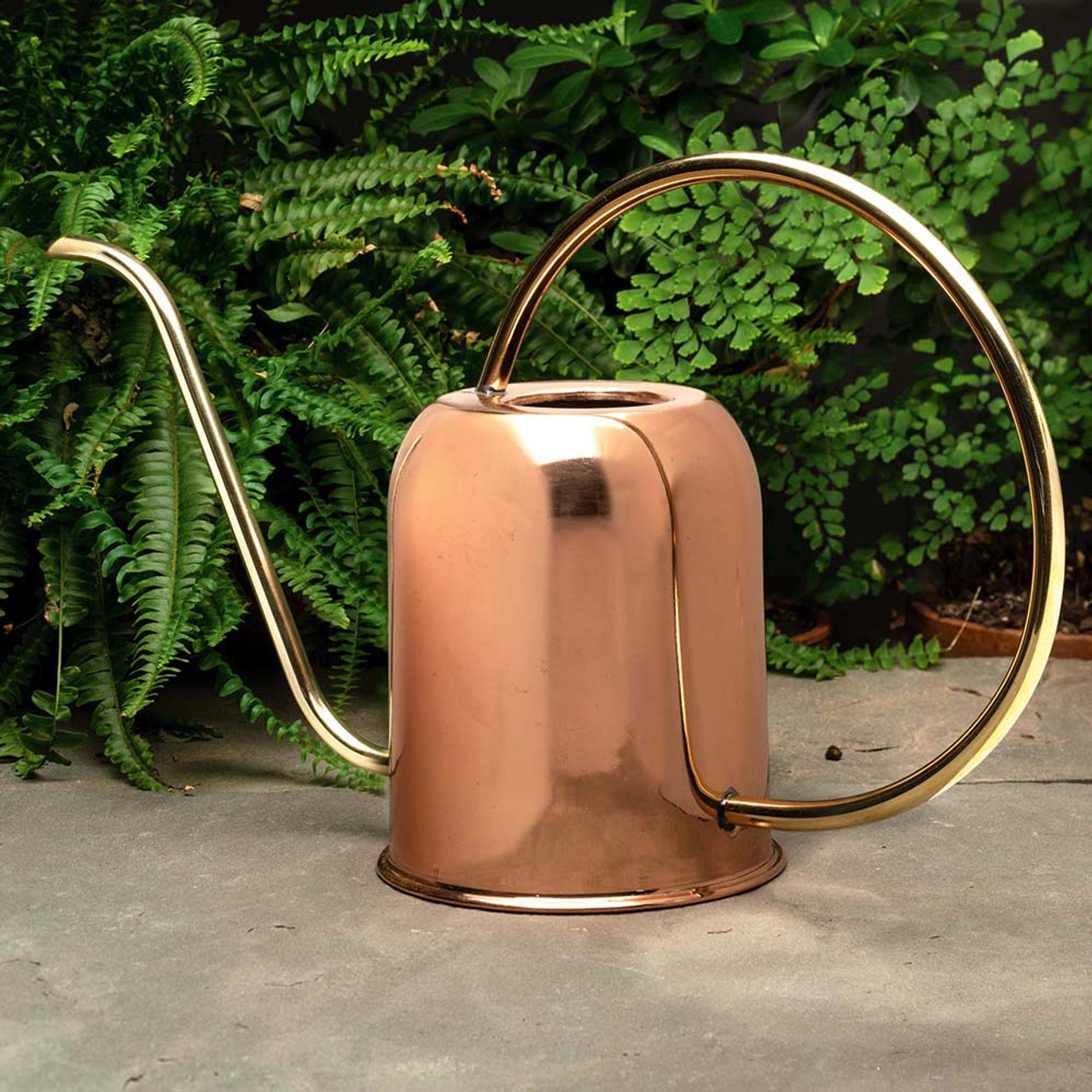
Indoor Gardening: Efficient Indoor Watering Can Options
The Importance of Choosing the Right Indoor Watering Can
Choosing the right indoor watering can is vital for plant health. A good can ensures water reaches the roots without spillage. It also keeps leaves dry, preventing mold and disease. An ergonomic design reduces hand strain during long watering sessions. Plus, the right size means less refilling, saving you time. Look for a can that balances function with aesthetics to enhance your indoor gardening experience. When you select the right indoor watering can, you nurture your plants and make your gardening more enjoyable and efficient.
Different Types of Indoor Watering Cans
When selecting an indoor watering can, you will find a variety of types to choose from. Each type has its own unique benefits, catering to different watering needs and preferences. Here are the main types you may encounter:
- Plastic Watering Cans: Lightweight and affordable, these are common for casual indoor gardeners. They come in a range of sizes and colors.
- Metal Watering Cans: Often more durable than plastic, metal cans offer a classic look. They may include galvanized or stainless steel options, which resist rust.
- Ceramic Watering Cans: These add an aesthetic touch to your collection. However, they are often heavier and should be handled with care.
- Long Spout Watering Cans: These types have a narrow, long spout that allows for precise watering, minimizing spillage and avoiding moisture on leaves.
- Decorative Watering Cans: While functional, they focus on design and can double as interior decor.
Each type of indoor watering can serves a specific role in the care of houseplants. Plastic cans are great for their versatility, while metal cans can add a touch of style and often last longer. For those who prioritize design, ceramic and decorative cans serve as both a tool and a piece of home decor. Long spout cans excel in their ability to reach tight spaces and dispense water efficiently. Consider your watering habits, plant types, and the size of your indoor garden when choosing the right type of can.
Key Features to Look for in an Indoor Watering Can
When searching for an ideal indoor watering can, several key features should guide your choice. Here are some aspects to consider:
- Capacity: Size matters. Pick a can that holds enough water for your needs but isn’t too heavy to handle comfortably.
- Material: Durability is key. Choose from plastic, metal, or ceramic based on your preference for longevity and style.
- Design: Aim for ergonomic handles and spouts. This design helps prevent hand fatigue and ensures accurate watering.
- Spout Length: A longer spout reaches plants with ease and protects foliage by directing water to the soil surface.
- Balance: A good watering can should feel balanced, whether full or empty. It should pour smoothly without tipping over.
- Versatility: Select one that suits all your plants. A detachable spout can offer different watering streams.
- Aesthetics: It can be a decor piece too. Find a style that complements your interior space.
These features not only enhance the functionality of an indoor watering can but also ensure it fits into your indoor gardening routine seamlessly. By keeping these key features in mind, you’ll find a watering can that not only meets your indoor gardening requirements but also makes the task more enjoyable and less taxing on your hands.
Top Rated Indoor Watering Can Models
When it comes to top-rated indoor watering cans, several models stand out. Each offers features that cater to different indoor gardening needs. Here are some highly regarded models and their key attributes:
- The Classic Gallon: Known for its generous size and sturdy handle, this metal can is a hit for its balance and ease of use.
- The Slim Spout: Its long, slender spout is perfect for reaching into tight spaces. It’s the go-to for precise watering.
- The Modern Waterer: Combining style and functionality, this sleek plastic can has an ergonomic design and comes in vibrant colors.
- The Eco-Friendly Indoor Can: Made from recycled materials, it’s a favorite for environmentally conscious gardeners.
- The Mini Ceramic: Ideal for small plants, this ceramic can is as decorative as it is functional.
These models are popular for their reliability and ergonomic designs. Whether you have a vast array of houseplants or just a few, there’s an indoor watering can model to suit your needs. Aim to choose a can that feels right in your hand and matches your indoor garden’s scale.
Remember to balance functionality with aesthetics. The right indoor watering can will not only aid in the health of your plants but can also serve as a stylish accessory to your home. When selecting from these top-rated models, consider the capacity, material, design, spout length, balance, and aesthetics to ensure you make the best choice for your indoor gardening.
How to Use an Indoor Watering Can Effectively
To ensure your plants thrive, using an indoor watering can effectively is essential. Here are straightforward tips for effective watering:
- Check Soil Moisture: Before watering, touch the soil. If it’s dry a few inches down, it’s time to water.
- Water Evenly: Start from the base, covering the soil surface evenly. Avoid splashing the leaves.
- Use Room Temperature Water: Cold water can shock the roots, so let tap water sit until it’s room temp.
- Avoid Overwatering: Water until it seeps through the drainage holes, then stop. Overwatering leads to root rot.
- Water Less in Winter: Plants typically need less water in colder months, so adjust accordingly.
- Keep a Routine: Consistent watering helps plants stay healthy. Find a schedule that suits your plant’s needs.
By following these steps, you’ll provide your plants with the ideal amount of hydration without overdoing it. Remember, a good indoor watering can with a long spout aids in directing water right to the roots, which is key for plant health. Equip yourself with the right can for the job, and watch your indoor garden flourish.
Maintenance and Care for Indoor Watering Cans
Proper maintenance adds to the life of your indoor watering can. Follow these tips for care:
- Clean Regularly: Empty and rinse your can after each use. This prevents dirt buildup and rust.
- Dry Thoroughly: Wipe it down or air dry to stop moisture from causing damage over time.
- Inspect for Damage: Look for dents, leaks, or rust, especially with metal cans. Repair or replace if needed.
- Store Correctly: Keep your can in a dry place, away from direct sunlight and extreme temperatures.
- Handle with Care: Be gentle with ceramic cans to avoid chips or cracks.
By taking these simple steps, you’ll keep your indoor watering can in top shape. It will pour better and last longer. Caring for your can means easier work for you and healthier plants in your home.
DIY Indoor Watering Can Ideas
Creating your own indoor watering can is not only budget-friendly but also allows for personalized style. Try these DIY ideas to cultivate efficiency and charm in your home gardening routine:
- Repurpose Household Items: Look around for old bottles or jugs. Clear plastic milk jugs or detergent bottles make great watering cans. Rinse them well, and you’re good to go.
- Customize With Paint: Transform a basic can into a unique piece. Use waterproof paint to decorate metal or plastic cans in colors that match your decor.
- Add a Spout: Fix a long spout to a container to create a long spout watering can. This can help with precision watering of your indoor plants.
- Get Creative with Handles: For an ergonomic touch, attach a custom handle. A piece of braided rope or a bent metal wire can serve well.
- Drill Holes for Even Flow: If your DIY can needs a sprinkle effect, drill small holes in the cap. This turns it into a gentle shower for your plants.
By using these simple DIY solutions, you not only save money but also gain the satisfaction of crafting a tool that’s tailored to your needs. Each homemade indoor watering can is a testament to your creativity and commitment to your plants’ well-being.
Where to Buy Quality Indoor Watering Cans
For high-quality indoor watering cans, knowing where to shop is key. Here are places to consider:
- Local Garden Centers: These stores often have a variety of cans. You can feel the balance and check the design in person.
- Home Improvement Stores: They stock watering cans that are durable. You can find both basic and high-end models.
- Online Retailers: Websites offer a wide range of options. Look for user reviews to gauge quality.
- Specialty Gardening Shops: These focus on gardening tools. They might have unique, ergonomic cans not found elsewhere.
- Craft Markets: Sometimes you can find handmade, decorative cans here. They offer a personal touch to your gardening tools.
- Department Stores: They may have stylish options that double as decor. Check for a good blend of form and function.
When shopping, remember your must-have features. Compare prices and read reviews. Make sure you get a can that suits your indoor garden’s needs. Balance style with functionality for the best experience.
